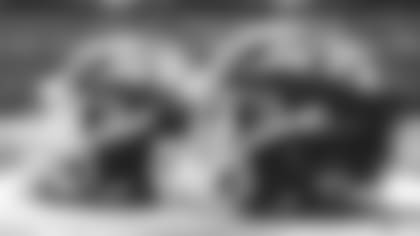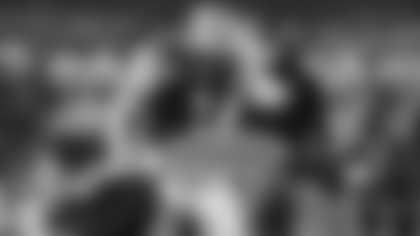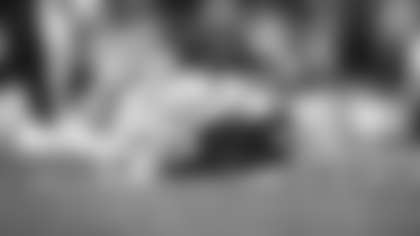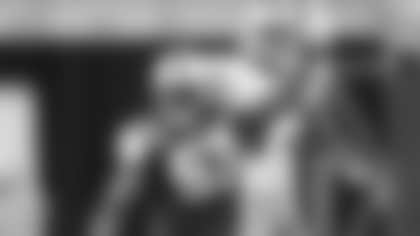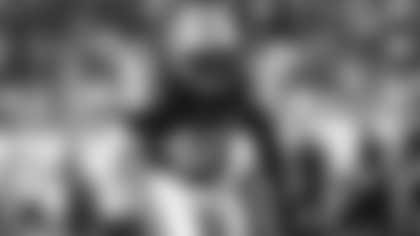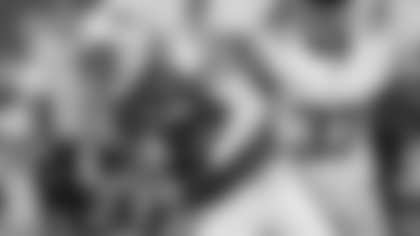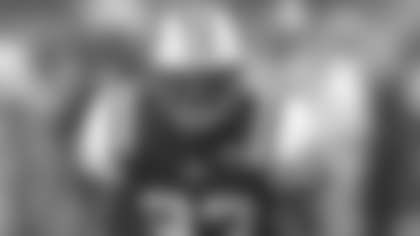
The second day of the 2001 NFL Draft was a case of good news, less than good news for University of Georgia cornerback Jamie Henderson.
The good news was that he was chosen by the Jets.
The less than good news was that it occurred one round later than he expected.
And when it was announced that he had been picked, it was also news that he got secondhand.
"Well, to be perfectly honest with you, I didn't see it (on television)," Henderson said. "I kind of was upset because I thought I was going to go in the third round. And so when that didn't happen, I walked off and may have been gone for probably about an hour just walking around the park. My mom called and told me that I had gotten drafted. To this day, I've never seen my name called."
While Henderson didn't get the customary, "Welcome to the team" phone call from head coach Herm Edwards on draft day, when they did speak a little later, it was memorable.
"My first conversation with Herm was when I came to visit," Henderson said. "And I remember he was saying that they're glad to have me in and that they're looking for good things from me. They're the Jets. I was happy to be in New York."
Once he was with the Jets, Henderson not only felt welcomed by his head coach, but was also quickly well-received and was shown the ropes by one of his new teammates who's now coincidentally holding the same job Edwards had at the time.
"Aaron Glenn. I had a couple others, Mo Lewis and Marvin Jones, but when I saw Aaron Glenn, I really saw what a pro was supposed to be like," Henderson said. "Everywhere I've been in my life, I always felt like, 'Oh, I was the best corner. I'm the best corner here.' Even when I played at Georgia. I mean, I saw Champ Bailey, and I knew he was kind of better than me, but I still wasn't ready to admit it.
"But when I got to the Jets and I actually saw Aaron Glenn, I thought to myself, 'Oh, my God, I'm not playing right. This is what a cornerback is supposed to look like.' And he was basically telling me how to be a professional on and off the field. How to carry myself. What to watch out for. What other guys may try to get me into, as far as the partying and clubbing. You know, me losing focus of why I'm there.
"So that was a big thing. But with me, I was a person that never really partied like that anyway. But I understood the assignment he was telling me."
One of Henderson's assignments during his first preseason was to show what he could do on the field against NFL-caliber players. During a game against Pittsburgh, he proved that he could play much bigger than his 202-pound frame when he stopped Steelers fullback Jerome Bettis, who was a swig of Gatorade over 250, on the goal line not once, but twice.
"You know what the funny thing is, I had been doing that my whole career: high school, college, the NFL," Henderson said. "If you would pull out practice film of me in high school having to go against the fullbacks, even at the Senior Bowl where they ran a toss sweep and I gave it to the fullback, nobody would have been surprised.
"But the fact that it hadn't been seen before out of a cornerback, it was a big surprise. But just like Coach Mike Westhoff said, 'It didn't surprise me because I've seen what he does out here on special teams.'"
Playing in all 16 games with one start as a rookie, Henderson finished the season with 16 tackles, one interception, and one forced fumble. He added 20 more tackles on special teams, and blocked a Todd Sauerbrun punt in the game against Carolina, which Chris Hayes returned for a touchdown in New York's 13-12 win.
Henderson's second season was disrupted because of a recurring right shoulder dislocation that allowed him to only play in two games.
"Once I had the injury, of course I was listening to the trainers and whatnot, and I was inactive for three games, but I came back and then I did it again and was out for the season. But I knew that I would come back strong," Henderson said.
"And I was very proud that I was able to because, honestly, I'd never sustained an injury that took me out for the season. I had an injury in college, a hip pointer, that took me out two games, but never one that took me out for the season. And so I was excited that I was able to bounce back from it."
He indeed did so in 2003, and at a new position, moving from cornerback to safety.
"It was a big adjustment. I was used to being closer to the action rather than at safety and being far back from the action," Henderson said. "Playing nickelback, it sort of put me back in college. My sophomore year, I played linebacker and it put me almost in that box.
"But going back to play safety, with so much space in between, it wasn't really comfortable. But I understood. Coach Herm told me I had the speed and the range to be out there at safety. So I tried to get acquainted with the position."
Playing in 14 games and finishing the year with 30 tackles, the Jets' season finale in Miami was also, unfortunately, Henderson's final game.
Fortunately, however, he's still with us today.
On April 3, 2004, Henderson was driving a motorcycle in his hometown of Carrollton, GA, when he lost control of it on a curve. The motorcycle then hit a curb and threw him 20 feet onto the ground.
While he wasn't breathing when an ambulance soon arrived, the EMTs were able to resuscitate him at the scene, and Henderson was then transported to a nearby ER. But after his brain began to swell, he was flown to a trauma center in Atlanta.
Diagnosed with cerebral edema, it's an injury which could lead to permanent brain damage and may result in the need of a wheelchair.
To keep him still and combat the pain, he was put in a medically induced coma for three weeks, which was when Edwards traveled to Georgia to see Henderson.
"When Herm actually visited, I was still in a coma, but my mom and dad told me that Coach Herm came to visit," Henderson said. "I was very grateful that he would visit me and show the concern for a person and not just a football player."
After he was awoken, Henderson made an incredible recovery over the next nearly four months that he spent in the hospital and rehab center. Besides the love and support he received from his family and friends; he also felt the backing by the Jets.
"It meant a lot. It showed a lot about the organization. It showed me a lot about what the owner was about. It's not just about football with him. That goes with a whole staff and I really thank them all for that," Henderson said.
"It actually showed the world that it's bigger than football. We have a person that we drafted, who we believe in. It didn't work out as planned, but we got to know Jamie Henderson."
Among those who knew him best were his teammates. And even though Henderson was rehabilitating in Georgia and they were practicing and playing in New Jersey, there was a bond with daily calls between him and them. And perhaps a life lesson, as well.
"I think they kind of knew after the accident that I had happened, that time in the NFL is not to be taken for granted because it's a young man sport," Henderson said. "You retire somewhere around 30, quarterbacks in their 40s now. And so it's not a career job that's going to last forever.
"Sometimes you learn from other people's mistakes. That's sort of what happened with me. People learned from my mistake."
Making his home in Powder Springs, GA, Henderson is a newlywed, and he and his bride, Natascha, have a "blended family" – Jalen, Jamie Jr., Adejianna, Justice, and Sanaa.
And as a way of paying it back to his community, for the past 13 years, Henderson has volunteer coached seventh grade football.
"I help kids learn the game, learn how to tackle the correct way, and learn certain coverages at an early age. Because a lot of things that were taught to me… Honestly, I didn't learn Cover 2 until college, and still didn't get the concept until I got to the NFL," he said.
"So some of the things I try to teach these kids now are a lot of different aspects of football, things that they will be getting later on through the ranks of football. And one of my players that I coached, he's in the league right now, Jonathan Jones. He played defensive back for the Patriots (and recently signed with the Washington Commanders)."



